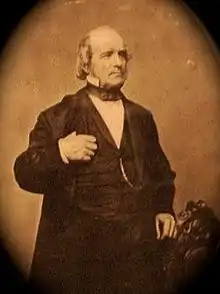Joseph Dart
Joseph Dart (1799–1876) was an American lawyer, businessman and an entrepreneur associated with the grain industry. He learned the Iroquois language and his Buffalo-based trading business benefited from the construction of the Erie Canal. Dart is credited with helping to invent the steam-powered Grain elevator.[1]

Biography
Dart was born at the Middle Haddam Historic District in the town of East Hampton, Connecticut in 1799. He came to Buffalo, New York, from Connecticut in 1821. There in the village of under 2,000 he went into the hat and fur business with Joseph Stocking. Dart learned to speak the Iroquois language to trade with the local Native Americans. Their store was at the corner of Main Street and Swan Street. It was strategically located and usually the first place a Native American would visit when they came to Buffalo. Chief Red Jacket visited frequently. Dart became known as a trusted businessman.[2]
The Erie Canal opened soon after he arrived in Buffalo and developed grain trading from local dealings into a multi-state industry. Since this was more lucrative it appealed to Dart as a businessman.[3] Dart financed the building of the first steam-powered grain elevator in the world in 1842 that was designed by thirty year old mechanical engineer Robert Dunbar.[3][4][5][6] He built the grain elevator building, known as Dart's Elevator,[7][8][9] in 1842 on the bank of the Buffalo river where it meets the Evans Ship Canal.[10] The Bennett elevator was later built at this property site.[5]
Family
Dart married Dotha Dennison of Norfolk, Connecticut in 1830. They had seven children. Their residence was on Swan Street, South Division Street and Erie Street successively, when each was a high prestige area.[2] Dart bought a larger than normal house on the northeast corner of Niagara Street and Georgia Street in 1858 to raise his large family.[2]
Businesses and societies
The invention had a profound effect on Buffalo and the movement of grains on the Great Lakes:
The grain elevator developed as a mechanical solution to the problem of raising grain from the lake boats to bulk storage bins where it remained until being lowered for shipment on canal boats or railroad car. Less than fifteen years after Joseph Dart's invention of the grain elevator, Buffalo had become the world's largest grain port, surpassing Odessa, Russia; London, England; and Rotterdam, Holland.[11]
Dart was a lumber dealer in the Buffalo area. He was a pioneer developer of the Buffalo Water Works, a founder of the Buffalo Seminary, and a member of the Buffalo Historical Society.[2]
Death and legacy
The grain elevator is Dart's greatest legacy. His innovations revolutionized the grain management industry worldwide.[2][12] His remains are buried beneath a stone marker in Buffalo's Forest Lawn Cemetery.[12]
References
- Rigg & Wood 2004.
- Malloy, Jerry M. "Dart Street in Buffalo; So Who Was Dart?". The Buffalo History Gazette. Retrieved October 1, 2015.
- Dixon 2008, p. 264.
- Alchin, Linda (2015). "Grain Elevators". Siteseen Ltd. Retrieved October 1, 2015.
Grain elevators were invented in 1842 by Joseph Dart and Robert Dunbar in Buffalo, New York to address the problem of unloading and storing grain transported via the Erie Canal.
- Green, H.J. (1888). "Buffalo's First Elevators and Mills". The Northwestern Miller. Miller Publishing Company. 26: 437. Retrieved October 1, 2015.
To Joseph Dart is due the honor of erecting the first storage and transfer steam-powered elevator in the world.
- Kane 1997, p. 4.
- "River tour shows off Buffalo's historic side". Amherst Bee. 2014-07-30. Retrieved October 1, 2015.
Joseph Dart built the first steam-powered grain elevator on the Buffalo River to help process the incoming and outgoing grain, which was previously loaded and unloaded by hand. Dart's elevator catapulted Buffalo into position as the top grain port in the world.
- Maio, Mark. "Grain Elevators: A History". The Buffalo & Erie County Historical Society. Archived from the original on September 8, 2015. Retrieved October 2, 2015.
- Baxter 1980.
- Brown 2009, pp. 104–109.
- "Nomination – Great Northern Grain Elevator 250 Ganson Street, Buffalo, NY". Buffalo Preservation Board. April 10, 2010. Retrieved October 2, 2015.
- LaChiusa 2014.
Sources
- Baxter, Henry H. (1980). Grain Elevators. Adventures in Western New York History. 26. Buffalo and Erie County Historical Society. ASIN B0006EAECY.
- Brown, William J. (2009). American Colossus: The Grain Elevator, 1843 to 1943. Lulu.com. ISBN 978-0-578-01261-2.
- Dixon, Laurinda S. (2008). Twenty-first-century Perspectives on Nineteenth-century Art: Essays in Honor of Gabriel P. Weisberg. Associated University Presses. ISBN 978-0-87413-011-9.
In 1842, Dart financed the construction of the first steam-powered grain elevator, the name by which these new structures for storing, weighing, and shipping grain came to be called.
- Kane, Joseph Nathan (1997). Famous First Facts, Fifth Edition. The H. W. Wilson Company. ISBN 0-8242-0930-3.
The first grain elevator operated by steam to transfer and store grain for commercial purposes was designed by Robert Dunbar and made by Jewett and Root for Joseph Dart, Buffalo, NY, in 1842. The first cargo of corn was unloaded on June 22, 1843, from the South America.
- LaChiusa, Chuck (2014). "History of Buffalo – Joseph Dart". Center for the Study of Art, Architecture, History and Nature. Retrieved October 2, 2015.
- Rigg, J. M.; Wood, Beth F. (2004). "Dart, Joseph Henry (1817–1887) lawyer". Oxford Dictionary of National Biography (online ed.). Oxford University Press. doi:10.1093/ref:odnb/7172. Retrieved October 1, 2015.CS1 maint: ref=harv (link) (Subscription or UK public library membership required.)(subscription required)
External links
- History of Buffalo – Joseph Dart
- Glenn, Daniel Patrick (November 14, 2007). "Thesis of Daniel Patrick Glenn". p. 226. Retrieved October 1, 2015.
The following year, however, Joseph Dart built the first steam-powered grain elevator